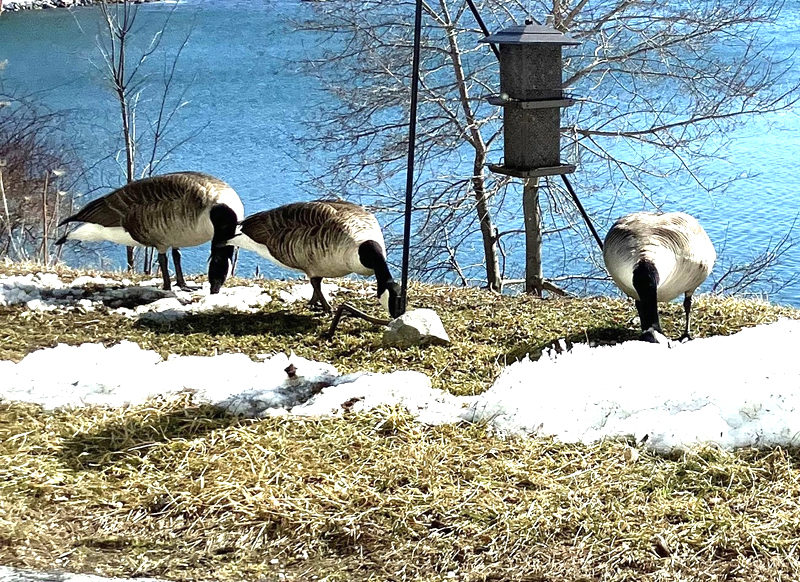
Canada geese grazing on small dead or dried lawn plants. They look round and fat, but that is just their thick layer of goose down, covered by sleek, waterproof feathers. Under all the down and feathers they must be bony thin after this long, snow-locked winter. (Photo courtesy Nancy Holmes)
Wild geese are supposed to fly south in the fall. Their yodeling calls bring us to pause our leaf raking, to look up at the “Vee” of birds heading toward the southern horizon. We may shiver a little and wonder: do we really want to be here through weeks of cold and snow?
Perhaps, back in the fields by the river, geese pause with a bill full of lush fall grass, and look up, hearing the calls from the sky; feeling, maybe, a tug to raise their wings and join the flight toward green winter grass.
As our Maine winters turn milder, that urgent call from the sky seems to have lost some strength. When I see young geese practice flying in a vee, just to land back on their home fields, I feel like calling to them, “Go! What are you going to eat when the grass is under the snow? Go!” But fewer geese do go south than they used to. They can find sunny, sheltered places to fill their crops with grass often enough to survive here until spring thaw.
The last few weeks stayed cold and snowbound. A couple of hungry geese struggled up the hill to the birdfeeder and ate sunflower seeds. Can geese digest sunflower seeds? A few days later, three geese wandered back and forth on the ice looking up the hill at the birdfeeder. One struggled part way up the hill before it slid back down.
When I looked out again, two geese were up next the birdfeeder, urgently pulling dry bits of plants where the sun had melted a small bare spot. As it grew dark, the third made a feeble attempt to come up the bank, then waddled slowly back onto the ice, where it settled down. I worried that its feathers would get frozen into the ice, trapping it.
Until it was too dark to see, I watched the two desperately snatching bits of dry grass, as the third waited down on the ice, head up, watching.
At first light in the morning, I expected to see two geese resting or eating dry grass by the birdfeeder. The third, I expected was either dead on the ice, or carried away by a hungry scavenger. However, there were no geese at all! The ice had broken up with the high tide, leaving no trace of the downed goose and the other two had flown.
(Nancy Holmes prowled Linekin Neck in Boothbay as a child, then an Illinois bottomland while earning a master’s degree in wildlife management. Once back in Maine, she raised children and kept assorted animals, wild and domestic. She and her Carolina dog roam their woods in Newcastle. Write to Holmes at castlerock@tidewater.net.)



